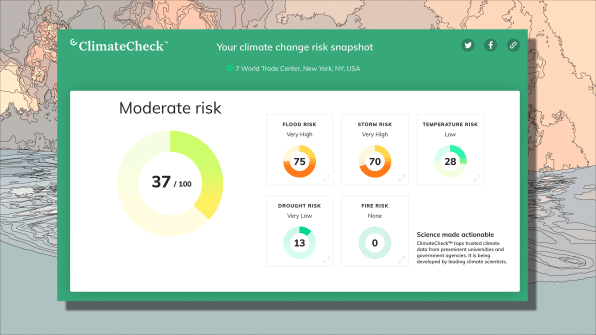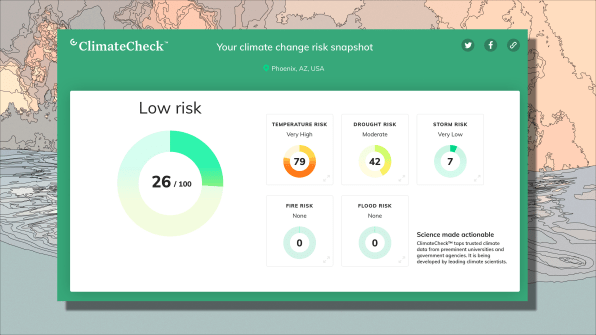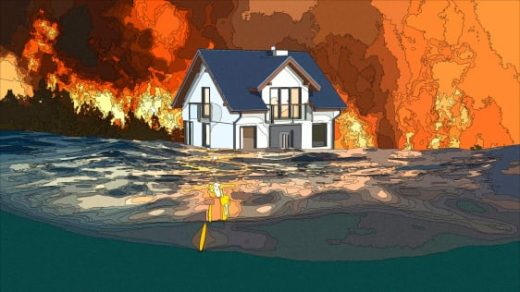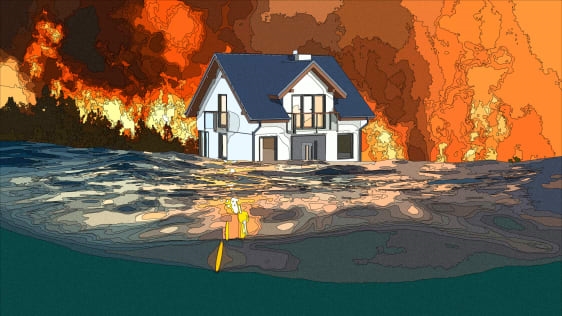See how susceptible your home is to fires, floods, and other climate disasters
Type your address into the ClimateCheck website, and you’ll instantly see a snapshot of your home’s climate risk across five areas: storms, temperature, drought, fire, and flood. Though you can’t quite outrun climate change physically—eventually all of the places in the U.S., and the world, will be impacted in some way—knowing these risks can let homeowners know what they have to do to make their homes more resilient, and can help people understand what to expect when they’re looking to buy a house.
This sort of risk data has long been limited to institutions like banks and insurers, says Skylar Olsen, ClimateCheck’s principal economist. “ClimateCheck is targeting every day consumers, so mom and pop investors but also homebuyers and sellers, to resolve that information asymmetry,” she says.
Each of the five risks are rated between zero to 100, based on climate models from agencies including the Intergovernmental Panel on Climate Change, the National Oceanic and Atmospheric Association, FEMA, the U.S. Forest Service, and others. Academic experts then localize that data to make it relevant for a specific region. The site explains what you usually experience in a year for that category: how much land within a certain mile radius usually burns around your home’s location, or how many significant storms you see a year, and how much precipitation those storms usually drop.

“ClimateCheck is also trying to not just provide information about risks to your home, your property damage . . . but also trying to capture this livability idea,” she says. Take the temperature risk, for example: high heat may not destroy your home, but extreme heat kills more Americans each year than other disasters, and it’s becoming more common.
These risks are also put into local context. Temperature risk doesn’t have the same threshold everywhere, for example. In Phoenix, Arizona, the site notes that “a day that reaches above 110ºF is considered hot for your location,” and normally a resident there would experience about eight hot days per year, but in 2050 they’re expected to experience 49 hot days per year. In Seattle, Washington, a day that reaches above 85 is considered hot; someone there normally sees eight of those hot days per year, and in 2050 can expect 28. Most homes in Seattle don’t have air-conditioning, so heat could also affect those residents differently.

Olsen hopes that people who already own homes can use the site to make their houses more resilient. If someone sees their home is at a high flood risk—not permanent sea level rise, but more frequent storm surges—they might look into putting their home on risers, or pushing their municipality to upgrade its pump and sewer systems. For people looking to buy homes, it’s about understanding the risks in their area, and also how that might affect the housing market. We tend to still think seaside properties are valuable because we like living by the water, but in some places with high flood risk, oceanfront houses aren’t rising in value as quickly as they once did.
This idea of making climate change-related risk information more publicly available has been gaining traction. A former deputy secretary of the Treasury has urged financial regulators to consider climate change in their risk assessments, and sites like Augurisk show a home’s disaster risks (Augurisk provides one partial risk audit for free and fuller reports on a sliding pay scale; both the initial and premium reports on ClimateCheck are free, and Olsen says they don’t have current plans to monetize, because they want the average person to have access to this data).
While once this data of what might happen to your property decades in the future was hard to find, ClimateCheck hopes it can be something every homeowner and buyer can now consider, and factor into their decision making over resilience efforts or where to live. “It’s for everybody to have access to this kind of information,” she says, “so that it’s not a really abrupt decision later, when it’s more about catastrophe.”
(15)



